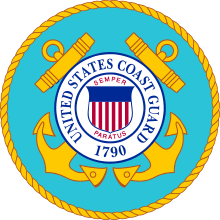Uniforms of the United States Coast Guard Auxiliary
The uniforms of the United States Coast Guard Auxiliary serve to distinguish Auxiliarists from members of other civilian auxiliaries and of other armed services. Auxiliarists are expected to wear a uniform intended for the situation and mission.[1] Each auxiliary uniform is identical to a Coast Guard officer's military uniform, with the exception that the buttons and stripes on dress jackets and shoulder boards are silver in color, rather than gold. On dress uniforms, appointed staff officers wear insignia with a red "A" and elected officers wear insignia with a blue "A", while black "A"s are worn on insignia by both elected and appointed officers on the ODU uniform. Auxiliarists are expected to adhere to the same rules of correct uniform wear as regular Coast Guard officers. When augmenting Coast Guard personnel, the military-style insignia of Auxiliary position is generally removed and the organizational insignia is worn.
Rank insignia and awards

While Auxiliarists wear military style rank insignia to signify office or position, they do not use military titles.[2] For example, a Flotilla Commander wears insignia similar to a USCG lieutenant, but is never referred to as "Lieutenant John Smith" or "Flotilla Commander John Smith" The title most commonly used in official correspondence, reports, and forms is "Auxiliarist", and its abbreviation (e.g., Auxiliarist John Smith or AUX J. Smith).[2] Exceptions to this rule are elected or appointed Commodores, who wear one to three stars depending on their office, and are the only Auxiliarists who use a military style title ("Commodore") and its abbreviation before their name (e.g., Commodore Jane Jones or COMO J. Jones).[2]
Auxiliarists may be awarded medals and decorations of the Coast Guard or Coast Guard Auxiliary, and may wear medals and decorations awarded in prior military service.[2] Whereas active and reserve Coast Guardsmen may only wear certain badges and awards earned while serving with other branches, Auxiliarists may generally wear any previously earned awards.
Dress uniforms
Auxiliarists generally wear the same dress and service uniforms as active duty personnel, but with Auxiliary-specific insignia and (on dress uniforms) silver buttons and braid instead of gold. There is one notable exception – because the Auxiliary does not award full-sized versions of its medals, Auxiliarists are de facto precluded from wearing the Full Dress Blue and Full Dress White uniforms.
Prior to 1972, all Coast Guard personnel, including Auxiliarists, wore the same uniforms as the United States Navy, with distinctive Coast Guard insignia. In 1972, Commandant of the Coast Guard Admiral Chester R. Bender introduced a new set of blue uniforms for wear by all personnel, which were also adopted by the Auxiliary. Unlike Navy uniforms, the new "Bender's blues" uniforms made few distinctions between officers and enlisted personnel, with all ranks generally wearing the same style of uniform (with the exception of a few formal uniforms reserved for officers only). Where Coast Guard uniform regulations and customs do differentiate between officers and enlisted personnel, Auxiliarists usually follow the rule for officers.
For those Auxiliarists who do not wish to wear military-style dress uniforms, a blue blazer with an Auxiliary crest may be worn with grey slacks (or skirt), a white shirt and navy necktie or black bowtie.
Service dress uniforms
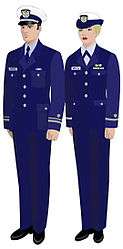 Service Dress Blue Bravo
Service Dress Blue Bravo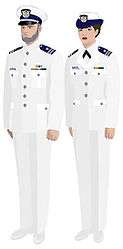 Service Dress White (no longer authorized)
Service Dress White (no longer authorized)
Undress uniforms
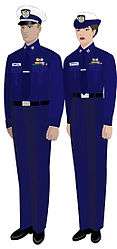 Winter Dress Blue
Winter Dress Blue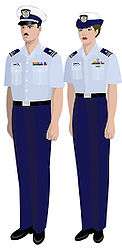 Tropical Blue
Tropical Blue
Dinner dress uniforms
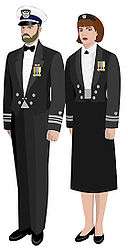 Dinner Dress Blue Jacket
Dinner Dress Blue Jacket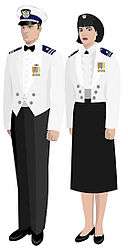 Dinner Dress White Jacket
Dinner Dress White Jacket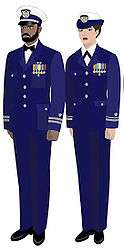 Dinner Dress Blue
Dinner Dress Blue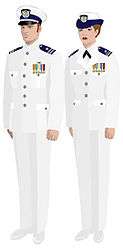 Dinner Dress White (no longer authorized)
Dinner Dress White (no longer authorized)
Working Uniforms
Auxiliarists wear the Operational Dress Uniform (ODU) as the standard working uniform. The ODU is similar to the old-style Battle Dress Uniform both in function and style, but in a solid dark blue with no camouflage pattern, and lacking lower pockets on the blouse. Composite toe boots are the standard footwear, but brown leather boat shoes may be (and frequently are) prescribed for wear. In the fall of 2008 a second generation Operational Dress Uniform was introduced, with the major change being that the blouse is worn with the tails on the outside, rather than tucked-in. In addition it has a black Coast Guard insignia embroidered on the left shirt pocket as well as the cargo pockets of the trousers. A baseball cap-style cover, with "U.S. Coast Guard Auxiliary" embroidered in silver block lettering, is worn with the ODU. There is also an optional broad-brimmed "sun hat" available.
Auxiliarists also have several distinctive working uniforms and optional uniform items not authorized for active duty personnel. The Hot Weather Uniform consists of the ODU t-shirt, dark blue cargo shorts, and the baseball cap. Either brown leather boat shoes or black ankle boots may be worn. The Hot Weather Uniform was formerly authorized for active duty personnel, but was withdrawn from service because of its non-military appearance.
A dark blue "operational polo shirt" may be worn in lieu of the ODU blouse, or in lieu of the ODU t-shirt with the ODU and the Hot Weather Uniform. A light blue "Vessel Examiner polo shirt" is also available for Auxiliarists conducting vessel safety checks.
Although Coast Guard personnel wear the Navy Working Uniform ("NWU") Type III while attached to expeditionary an deployable units, because Auxiliarists are non-combatant volunteers, and not subject to mobilization or deployment, it is unlikely an Auxiliarist would ever be required (or permitted) to wear the NWU.
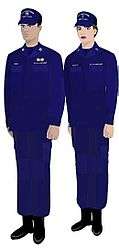 Operational Dress Uniform (ODU)
Operational Dress Uniform (ODU)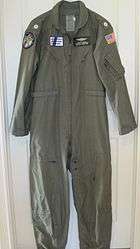 Flight Suit[3]
Flight Suit[3]
Notes
References
External links
| Wikimedia Commons has media related to USCGAUX Uniforms. |
